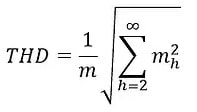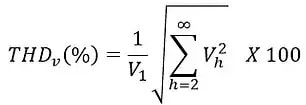In an increasingly interconnected and technology-driven world, the quality of electrical power and the reliability of electronic devices are paramount concerns. As we rely on a vast array of electronic equipment for various applications, from home appliances to industrial machinery, the integrity of electrical signals becomes crucial. One critical aspect in assessing the purity of these electrical signals is Total Harmonic Distortion (THD). THD is a measure that quantifies the extent to which a signal deviates from its ideal sinusoidal waveform by accounting for the presence of unwanted harmonics or frequency components. In this introduction, we will delve into the concept of THD, exploring its significance, measurement, and implications in the realm of electrical engineering . Understanding THD is fundamental not only for engineers and technicians but also for consumers seeking to ensure the optimal performance and longevity of their electronic devices and systems.
What is Total Harmonic Distortion (THD)?
Total harmonic distortion is a measurement that informs you how much of the current or voltage distortion is present within the signal because of harmonics. This is an important feature within power systems, audio & communications. In other words, it can be defined as the ratio of the sum of all harmonic components’ power and the fundamental frequency power.
The effects of total harmonic distortion mainly include loss of efficiency within electrical systems, overheating in electrical systems & motors, insulation materials degradation, motors & generators malfunctioning, MCBs tripping, blown fuses, power systems damage, etc.
When the sinusoidal voltage is given to linear devices (resistors, inductors, and capacitors) then the flow of current supply drawn through these devices changes based on the difference of sinusoidal voltage. So, both current & voltage waveforms do not establish any harmonics within the network supply.
Similarly, if the sinusoidal voltage is given to nonlinear semiconductor devices, then the flow of current throughout these devices does not change according to the applied sinusoidal voltage. So the distorted current waveform establishes harmonics within the system. Further, the current distortion exacerbates once the voltage applied is also altered.

Linear and Non Linear Loads of Total Harmonic Distortion
Total Harmonic Distortion Measurement
The distortion caused by harmonics within current & voltage waveforms is known as harmonic distortion. So, the supply system can be polluted by harmonics & which also reduces the electrical network supply efficiency.
The harmonics within the supply network can cause many problems & it is also very harmful to electrical equipment. So harmonics measurement & their improvement is a must to maintain the efficiency of the power system.
The total harmonic distortion or THD is measured to verify the number of harmonics present within the power supply system. The total harmonic distortion (THD) for signal ‘m’ can be defined by using the below equation.

Total Harmonic Distortion Equation
The THD of voltage & current can be measured simply in terms of THDi & THDv. The harmonic current which is drawn through no linear devices can cause distortion in voltage & once more the distorted voltage can cause current distortion. So, it is important to lessen the harmonic current for avoiding electrical pollution.
THD of Voltage or THDv
The THDv or THD of voltage can be defined as the ratio of the addition of all the harmonic voltages root means squares to the RMS voltage of basic frequency. So the THDv equation in percentage can be given as;
THDv (%) = √(V22 + V32 + V42 + V52 + V62+ V72)/V1) x 100
In the above THDv equation, V2, V3, V4…V7 are harmonic voltages whereas ‘V1’ is the basic voltage.
The THD generalized equation for voltage is given as;

THD of Voltage
If the distorted voltage waveform’s total RMS value is known, then the THD of voltage is calculated by using the below equation.

THD of Voltage with RMS
THD of Current or THDi
The THDi or THD of current can be defined as the ratio of the addition of all the harmonic current root means squares to the RMS current of basic frequency. So the THDi equation in percentage can be given as;
THDi (%) = √(I22 + I32 + I42 + I52 + I62+ I72)/I1) x 100
In the above THDi equation, I2, I3, …I7 are harmonic currents whereas ‘I1’ is the basic current.
The THD generalized equation for current is given as;

THD of Current
If the distorted current waveform’s total RMS value is known, then the THD of the current is calculated by using the below equation.

THD of Current with RMS
Total harmonic Distortion Calculation Example
For a THD of 0.2 with I1 = 5A & RC = 6Ohms then calculate total power.
The total harmonic distortion can be given by
THD = √(I22 + I32 + I42 + …)/I12
THD2 = (I22 + I32 + I42 + …)/I12
Now the total power because of all harmonic components is;
PT = ( I12 +I22 + I32 + …)X Rc/2
PT = I12 (1 + (I22 + I32 + …/TL))X Rc/2
PT = I12 (1 + THD2) X Rc/2
We know that THD is 0.2, I1 = 5A & RC = 6Ohms
Substitute all these values in the above equation to get the total power value.
PT = (5)2 (1 + (0.2)2) X 6/2
PT = 25 (1 + 0.04) X 3
PT = 25 (1.04) X 3 = 78W
Implications of Total Harmonic Distortion:
Total Harmonic Distortion (THD) carries specific implications for the electrical industry, where the generation, distribution, and utilization of electrical power are central. Here are the implications of THD in the electrical industry:
- Grid Stability: High THD levels in power generation or distribution networks can destabilize the grid. Harmonic currents can interact with the impedance of power lines, transformers, and other grid components, leading to voltage distortion and reduced grid stability.
- Transformer and Equipment Overheating: Excessive harmonics can cause transformers and other electrical equipment to overheat. This can lead to insulation degradation, increased maintenance costs, and a reduced lifespan of these critical components.
- Energy Efficiency: The electrical industry is increasingly focused on energy efficiency. High THD can lead to increased energy losses in power transmission and distribution systems, making it more challenging to meet efficiency targets.
- Regulatory Compliance: Utilities and power providers must adhere to regulatory standards regarding THD levels in electrical systems. Failure to comply with these standards can result in penalties, fines, or legal action.
- Power Factor Correction: Many industrial and commercial facilities are required to maintain a good power factor to avoid penalties from utilities. Harmonics can worsen the power factor, necessitating additional power factor correction equipment, which adds costs to electrical systems.
- Renewable Energy Integration: As renewable energy sources like wind and solar become more prevalent, they can introduce harmonics into the grid due to their variable nature. Managing THD is crucial to ensure the smooth integration of renewable energy sources into the existing grid.
- Equipment Compatibility: The electrical industry relies on various types of equipment, including motors, generators, and control systems. High THD can lead to compatibility issues, affecting the performance and longevity of these devices.
- Diagnostic and Monitoring Tools: THD analysis is an essential diagnostic tool for identifying and resolving power quality issues in electrical systems. Monitoring and analyzing THD levels help diagnose problems, improve system reliability, and reduce downtime.
- Harmonic Mitigation Solutions: The electrical industry has developed a range of solutions to mitigate harmonics, including passive filters, active filters, and specialized harmonic-resistant equipment. These solutions help control THD levels and maintain system integrity.
- Grid Planning and Design: When designing new power distribution systems or upgrading existing ones, engineers must consider THD mitigation strategies. This includes selecting appropriate equipment and designing systems to minimize harmonic distortion.
Emergency Power Systems: High-quality power is crucial for emergency power systems in critical facilities such as hospitals and data centers. Managing THD is essential to ensure the reliability of these systems during power outages.
Advantages
The advantages of total harmonic distortion include the following.
- THD is a prominent feature within power systems.
- In power systems, lower THD means lower peak currents, less heating, higher power factor, less core loss within motors, lower electromagnetic emissions & higher efficiency.
- THD analysis is essential in enhancing & maintaining the stability of the power system.
Disadvantages
The disadvantages of total harmonic distortion include the following.
- Generally, harmonic distortions can be caused by using nonlinear loads by the electricity end users.
- Higher frequency harmonics can cause extra core loss within motors so it results in extreme motor core heating.
- Unwanted distortion enhances the current within power systems, resulting in high temperatures within distribution transformers & neutral conductors.
How do Harmonics Affect Capacitors?
Capacitors are mainly responsive to harmonic currents because their impedance proportionally reduces to the order of the present harmonics. Since the capacitor’s impedance reduce by increasing in frequency and large harmonic current will supply into capacitors.
How to Reduce Total Harmonic Distortion?
The THD can be reduced by using numerous control methods like the p-q method, active filter, Diode switch, passive filter & harmonics filter through the thyristor device.
What is the Unit of Total Harmonic Distortion?
The total harmonic distortion is typically expressed in dB or percent relative to the fundamental distortion attenuation.
What Causes Current Harmonics?
Current harmonics can cause overheating & unwanted current.
Does Harmonics Affect Power Factor?
Harmonics produced by non-linear loads will introduce distortion reactive power so this power will reduce the power factor.
Thus, this is an overview of total harmonic distortion or THD, measurement, example, advantages, and disadvantages. Total harmonic distortion is mainly used to measure the variation of current or voltage waveform from an idyllic sinusoidal shape. So, THD simply measures the unnecessary harmonics that are available within the current or voltage waveforms with Fourier analysis. The analysis of THD is important to maintain and improve the stability of the power system. Here is a question for you, what is the distortion factor?